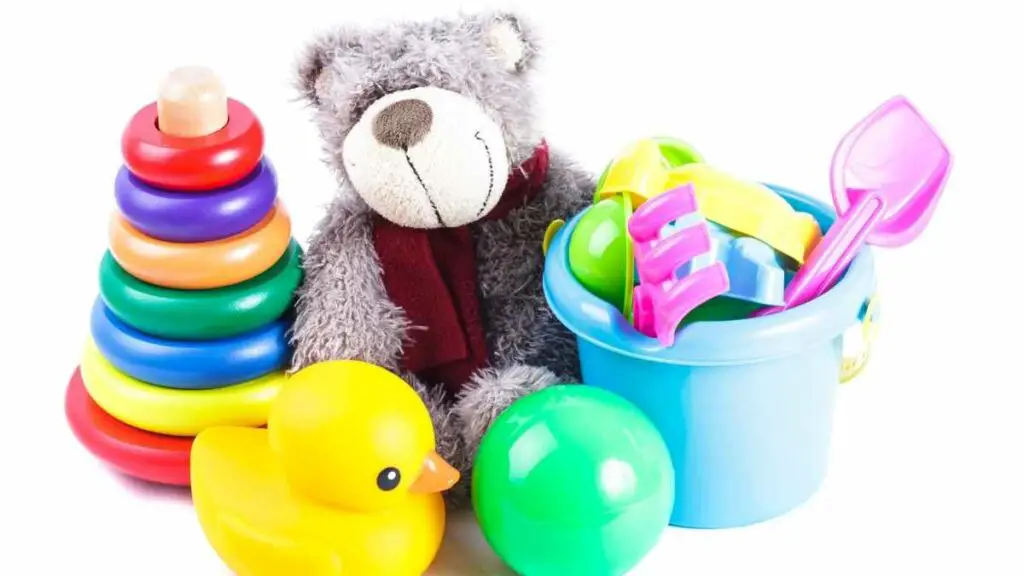It was a massive challenge for my toddler son and me!
I was woken up most nights, and sleep was slipping away. In this post, I will look at some toddler self-soothing behaviors to ensure you get enough good-quality sleep!

It was not just me going through it. I have a friend who was going through the same thing. So I asked them for some advice and some self-soothing techniques for toddlers.
Here it is:
Toddler Self-Soothing – Layla’s Story
Throughout Lala’s infancy, she had problems sleeping. I spent months poring through research journals and interviewing pediatricians. Very little changed; my toddler hadn’t learned to self-soothe.
Neither of us was getting the recommended seven to eight hours of sleep at night.
Before long, my blood pressure started increasing, and Lala began complaining of recurring headaches.
I became desperate for a permanent solution to our sleep challenges. I saw a therapist who suggested that Lala learns to self-soothe.
-

Bold Male Pride – Baseball Trucker Cap Celebrating Masculinity
£18.00 Select options This product has multiple variants. The options may be chosen on the product page -

Dad Bod Appreciation Gift Mug
£14.00 Add to cart -

Dad Bod, Bad Jokes Structured Baseball Cap
£22.00 Select options This product has multiple variants. The options may be chosen on the product page
Child therapists suggest that self-soothing is an important phase in every toddler’s development. To cope with discomfort and other stressful situations, toddlers adopt habits that make them feel secure and calm.
Self-soothing was—and still is—a life-long skill my toddler had to learn so that she could rock herself to sleep in my absence.
Here, I’ll share the self-soothing hacks that worked for Lala and me.
Common Toddler Self-Soothing Behaviors
As children mature, they adopt different strategies and techniques that help them stay calm enough to sleep independently. Unfortunately, these repetitive activities often seem funny and weird to uninformed adults.
However, child therapists have revealed that these behaviors are essential signs of neural development.
Toddlers adopt self-soothing behaviors to help them regulate their emotions and moods.
When Lala eventually learned to self-soothe, she had fewer episodes of tantrums and better moods. She also showed more signs of self-control.
With her newly acquired self-soothing skills, she coped better in stressful situations. What’s more, she began sleeping for longer hours, and my blood pressure dropped to a healthier range.
Listed below are all the socially acceptable self-soothing behaviors I taught Lala.
Stroking Blanket Between the Toddler’s Little Fingers
This is at the top of the list for toddler self-soothing behaviors!
Toddlers especially like this self-soothing strategy. The warmth of the blanket gives them a calm womb-like comfort. Lala loved her pink blanket.
Now Lala is almost four. And whenever she wakes up in the middle of the night, she clutches her favorite cotton blanket to her chest and fiddles with it until she drifts back to sleep.
According to child therapists, toddlers love comfortable things and associate current events with pleasant memories. Lala loves fiddling with her blanket because it reminds her of the warmth of my womb.
The blanket also reminds her of the skin-to-skin contact she experienced in her breastfeeding days. This soothing activity is worth considering.
Humming that induces gentle vibrations in the chest.
Humming is another self-soothing skill for toddlers. With each hum, the toddler’s chest vibrates a little.
A sense of calm suddenly washes over the child. It’s pretty easy to teach a toddler to hum. All you have to do is show by example.
Children learn very fast.
Teaching Lala this self-soothing behavior was relatively easy. At bedtime, I laid her on her bed and hummed rhythmically. Soon she followed suit and began humming herself to sleep. It was almost magical.
Because humming involved many repetitions and chest vibrations, her brain calmed down enough to induce sleepiness.
Shaking Head From Side to Side
Bodily movements help to soothe toddlers. While some children rock themselves while standing, others do this from a lying position. According to experts, they form neural pathways that cause repetitive rocking and other self-soothing behaviors.
This self-soothing strategy worked quite well. I shook my head from side to side and encouraged her to follow suit.
But I must admit that we often wound up rocking the entire body. But even that isn’t a terrible idea.
Repeatedly shaking the head helps the toddler self-soothe from a sensory level. It’s worth a try.
My best friend has a two-year-old son. His name is Jake. And when little Jake started daycare, he forgot almost all the self-soothing behaviors he’d learned.
He began twiddling his navel whenever he felt sleepy.
No one knows where he learned this, but it is one of the strangest self-soothing techniques for toddlers!
The first time the daycare teacher noticed Jake fiddling with his navel during naptime, she almost screamed in horror. She clamped her mouth shut, I think because she didn’t want to wake the other sleeping children.
None of the other toddlers in the class showed signs of weird self-soothing activities.
Fiddling with the belly button reminds toddlers of all those months when they curled up in their mom’s womb. This behavior reflects experts’ theories of toddlers adopting behaviors that bring them pleasant memories.
Lala didn’t need to try this. I only included it in my list because I realized it might work for another toddler.
How To Help My Toddler Self-Soothe

If your toddler has problems learning to sleep on their own, do not despair. You’re not alone. All over the world, toddlers struggle to sleep without the help of an adult.
To make your job easier, I have outlined and explained five effective ways to teach your child to self-soothe.
Set up a fixed bedtime
Toddlers are creatures of habit.
They learn faster when they are made to work with a fixed schedule or timetable. In matters of sleep, toddlers benefit more when there is an established consistent bedtime schedule.
Lala got used to the bedtime rituals very quickly. It started with a warm bath, a bedtime story, and lights out. Sticking to this pattern helped her fall asleep in her warm and cozy bed.
Occasionally, she hummed and hugged her favorite pink blanket. Sometimes, she rocked her stuffed animal to sleep as well.
Help your child cope with the dark bedroom.
If your toddler is afraid of the dark, you can leave on the lights in the corridor, especially if its silhouette filters through the cracks in the bedroom doorway.
A toddler or baby night light projector is an excellent idea to help your child stay in bed!
Because Lala had formed the habit of imagining monsters in the dark, I provided a warm, natural-looking light in the adjourning rooms.
Later on, I installed a nightlight bulb in her bedroom. This went a long way to help her overcome her sleep challenges.
Handle midnight episodes wisely.
When your toddler wakes in the middle of the night, pay attention. Listen through the door and wait for five to ten minutes.
Your child needs adequate time and space to practice the self-soothing strategies they’ve learned. If they keep crying, calmly walk into the room and soothe them.
Ask them what the problem is. Reassure your toddler of your love, care, and protection. Be wary of night-terrors in toddlers!
When Lala woke up in the middle of the night, I kissed her and encouraged her to hum and rock her stuffed animal or blanket.
The self-soothing techniques calmed the brain. She always fell asleep after a few minutes.
Be consistent
Don’t give up after a few nights. If you maintain a regular bedtime routine and a smart midnight intervention strategy, your toddler will adjust.
With time, your toddler will develop the skills required to sleep independently. What’s more? They will also cry less.
It took Lala about one week to learn to self-soothe. However, children learn at different paces. For example, your toddler might take less than a week to learn, but they might also take more than two weeks too.
Studies by educational psychologists suggest that there are individual differences and that children learn at different rates. Be patient with your toddler.
Recommended Purchases For Self-Soothing

Teaching your little one some toddler self-soothing behaviors is a challenge! Often, you will need to purchase helpful tools for your child. Below is a list of purchases that worked for me and some that worked for other parents I interviewed.
- Stuffed animals
- Soft, warm baby blankets
- Self-held feeding bottles
- A warm nightlight that has a natural glow
- A stereo and nature music mixed tape. The tape features birdsong, the hiss of rushing waters, and the swishing of forest trees and desert dunes.
- A white noise machine for toddlers and babies
At what age should you start self-soothing?
Very few babies are born with flawless sleep patterns and habits. Yes, some babies sleep for 6 – 8 hours at night, but these are the exceptions. In most cases, newborns wake up regularly for nightly feeds until they reach their third month.
At six months, 65% of babies sleep throughout the night. Once your baby reaches this stage, you can start teaching them to self-soothe.
Research has shown that early self-soothing lessons benefit children in the end. According to this 2002 study, babies who had learned to self-soothe by age one were unlikely to develop sleep challenges in toddlerhood and middle childhood.
Toddlers’ sleep patterns and associations are much more difficult to adjust when compared to a baby’s sleep habits. That makes it more of a challenge to build in some toddler self-soothing behaviors!
How do I teach my toddler to self-soothe?
The first step is to make your toddler’s bedroom warm, comfortable and cozy. Declutter the room. Place objects and toys that bring pleasant memories. Consider investing in self-soothing tools. Blankets, stuffed animals, self-held bottles, and birdsong are fantastic tools.
Establish a bedtime ritual and timetable. Choose rituals that are effective on multiple levels. Warm baths and (oil or water) massages soothe and comfort toddlers. After baths and massages, proceed to the bedroom and turn down the lights to a warm, soft glow.
Yellow candle-like flames are natural and soothing. Avoid the harsh glare of white LED or fluorescent lights. Instead, read a bedtime story, pray (if you want) and then encourage the child to hug a warm blanket or a stuffed animal. These activities create feelings of comfort and security.
When your toddler wakes up at night, get up and press your ears to the doorway. Listen for five minutes. If the child hasn’t gone back to sleep, open the door and soothe the child. Ask what the problem is.
Listen to what your child has to say. Afterward, hug them and encourage them to hum and rock their favorite stuffed animal, blanket, or self-held bottle,
Don’t linger in the room for too long. Leave after five minutes. You can wait outside and monitor the child’s progress from there. Often, the child will drift off to sleep without your help. If your toddler continues to cry, wait for seven minutes before you intervene.
Be willing to give your toddler adequate room to practice the self-soothing techniques they’ve learned.
How long should a toddler cry it out?

Every child is different. And in matters of self-soothing, there isn’t a one-size-fits-all guideline. Some experts say allowing your toddler to fuss and cry for about five to eleven minutes before you intervene is okay. Other experts recommend a longer duration.
Whatever you do, be sure to apply the law of moderation. Don’t let your toddler cry for too long, especially if they are ill.
Monitor your toddler. Ensure that they aren’t harming themselves while they are crying.
Can newborns self-soothe?
Experts believe newborns can self-soothing when they cross the three-month milestone (or when they turn twelve weeks).
However, it is important to note that newborns have tiny stomachs and cannot take sufficient amounts of food at once.
Often they have to wake up every one to three hours to feed. Babies who cluster feed are not capable of soothing themselves to sleep when they are hungry.
Before you start swapping self-soothing stories with other mothers, bear in mind that parenting tactics differ. Bottle-fed babies eat less than breastfed babies. And breast milk is more easily digestible when compared to baby formula.
In other words, breastfed babies are more likely to wake up more often for nightly feeds.
By the sixth month of life, two-thirds of babies can ingest more food at a time and of sleeping for longer hours. You can teach your baby to self-soothe when they reach the six-month mark.
Conclusion
Many toddlers struggle to sleep on their own. Often, toddlers insist on being held, rocked, or patted to sleep even when they wake up in the middle of the night.
Not only does this deprive the entire family of quality sleep, but it also robs the child of the opportunity to learn an important life skill. This is when it is a good idea to develop toddler self-soothing skills!
Toddlers who learn to self-soothe are more likely to:
- Regulate their moods
- Cope in stressful situations
- Concentrate in a formal school setting.
You can help your child self-soothe if you create a comfortable and cozy space for your child to sleep in. Fill your child’s room with soft blankets, stuffed animals, and other tools that are reminiscent of pleasant experiences.
Establish a bedtime ritual and stick to it.
Tuck your child into bed and encourage them to rock their stuffed animals or blankets. Hum to them and encourage them to hum as well.
Do not despair. Like Lala and I, you and your toddler will overcome your sleep troubles.
the key point is – you should teach your little one some vital toddler self-soothing behaviors!




